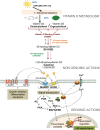Vitamin D, Cognition and Alzheimer's Disease: The Therapeutic Benefit is in the D-Tails
- PMID: 27176073
- PMCID: PMC4969697
- DOI: 10.3233/JAD-150943
Vitamin D, Cognition and Alzheimer's Disease: The Therapeutic Benefit is in the D-Tails
Abstract
Since its discovery during the epidemic of rickets in the early 1920s, the physiological effects of vitamin D on calcium/phosphorus homeostasis have been thoroughly studied. Along with the understanding of its actions on skeletal diseases and advances in cellular and molecular biology, this misnamed vitamin has gained attention as a potential player in a growing number of physiological processes and a variety of diseases. During the last 25 years, vitamin D has emerged as a serious candidate in nervous system development and function and a therapeutic tool in a number of neurological pathologies. More recently, experimental and pre-clinical data suggest a link between vitamin D status and cognitive function. Human studies strongly support a correlation between low levels of circulating 25-hydroxyvitamin D (25(OH)D) and cognitive impairment or dementia in aging populations. In parallel, animal studies show that supplementation with vitamin D is protective against biological processes associated with Alzheimer's disease (AD) and enhances learning and memory performance in various animal models of aging and AD. These experimental observations support multiple mechanisms by which vitamin D can act against neurodegenerative processes. However, clinical interventional studies are disappointing and fail to associate increased 25(OH)D levels with improved cognitive outcomes. This review collects the current available data from both animal and human studies and discusses the considerations that future studies examining the effects of vitamin D status on neurocognitive function might consider.
Keywords: Alzheimer’s disease; clinical trials; cognitive function; vitamin D.
Figures


References
-
- Hess AF (1924) On the induction of antirachitic properties in rations by exposure to light. Science 60, 269. - PubMed
-
- Steenbock H (1924) The induction of growth promoting and calcifying properties in a ration by exposure to light. Science 60, 224–225. - PubMed
-
- Mawer EB, Backhouse J, Holman CA, Lumb GA, Stanbury SW (1972) The distribution and storage of vitamin D and its metabolites in human tissues. Clin Sci 43, 413–431. - PubMed
Publication types
MeSH terms
Substances
LinkOut - more resources
Full Text Sources
Other Literature Sources
Medical

